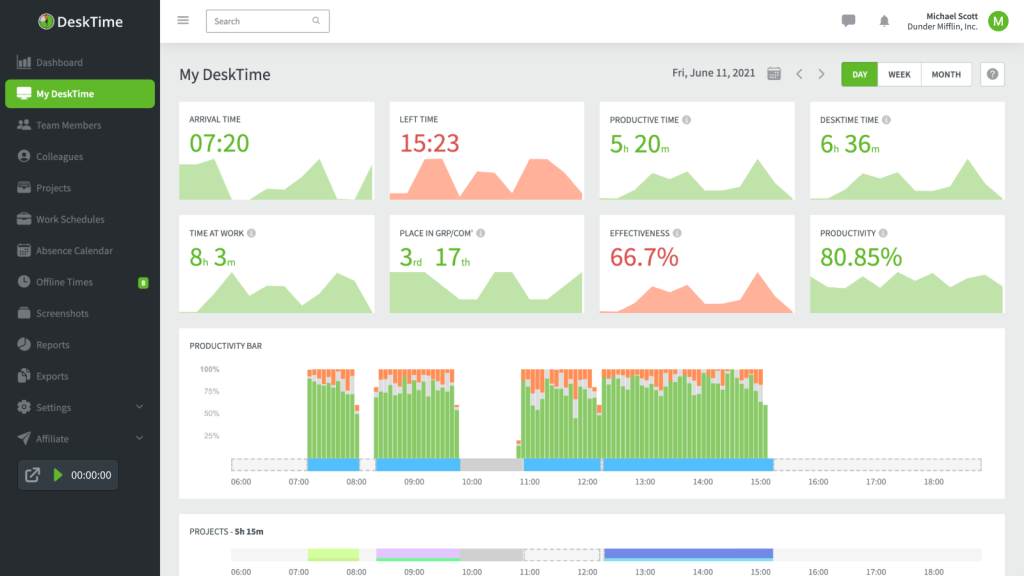7 tools to help you manage your email addiction

In today’s information-heavy world, email has become an essential part of our professional routines. However, if you find yourself constantly checking your inbox and struggling to stay focused on other tasks, you might have email addiction. But don’t worry – you can take back control of your inbox with some help.
In this blog post, we’ll introduce you to various tools that can assist you in overcoming the addictive cycle of email. From productivity software to specialized email clients, these tools can help you develop healthier email habits, boost productivity, and restore a sense of balance to your digital life.
Want to get the most out of your time?
Try DeskTime for free!
Try free for 14 days · No credit card required.
By signing up, you agree to our terms and privacy policy.

Check out these seven tools that can help you conquer email addiction:
Now, let’s explore them in more detail.
1. SaneBox

SaneBox is an email management tool designed to help users reduce email overload. It takes advantage of artificial intelligence and advanced algorithms to analyze your email behavior and automatically sort incoming messages into different folders or labels.
The application learns from users’ actions – such as which emails you frequently open and respond to and which ones you tend to ignore. By understanding your preferences, SaneBox can identify important messages and place them in your main inbox while diverting more trivial ones to separate folders.
The tool allows users to create custom folders and train the system according to their specific needs. For example, you can create a folder for emails from specific clients or projects to ensure they receive immediate attention.
SaneBox also provides features such as reminders and snooze options. You can set reminders to follow up on important emails or snooze messages that don’t require immediate attention, temporarily hiding them from your inbox until a specified time or date.
SaneBox is compatible with various email clients and platforms, including Gmail, Outlook, and Apple Mail.
Pricing: The basic version is available for $7 per month
2. DeskTime

If you suspect that you’re devoting too much time to emails, incorporating time tracking can offer a realistic perspective on the issue at hand. DeskTime offers a range of features designed to help individuals improve their focus, productivity, and overall work habits.
DeskTime tracks and analyzes how you spend your time on different tasks and activities – including email. By providing detailed insights into your email usage patterns, DeskTime can help you gain awareness of how much time you allocate to checking and responding to emails.
DeskTime provides productivity reports and analytics that showcase your email usage patterns over time. These reports can reveal patterns of excessive email use, highlight peak hours, and thus provide valuable data to evaluate and adjust your email habits.
DeskTime also offers productivity features such as a break time reminder – if you’re in the line of work where email communication is inevitable, you can still get some productive deep-work in by allowing yourself uninterrupted sprints of email-free work and then checking your inbox during breaks.
Pricing: After 14-day free trial, DeskTime pricing starts at $7/user ($6.42/user if you choose the annual billing option)
3. Mailstrom

Mailstrom is an email management tool that helps users organize and clean up their email inboxes.
The tool analyzes your inbox and presents a visual representation of email activities, allowing you to see patterns and trends. By displaying information such as the number of messages from specific senders or within certain time frames, Mailstrom can help you identify email sources that contribute to inbox clutter.
Mailstrom also offers useful filtering capabilities. Users can sort and filter emails based on different criteria – such as sender, subject, size, or age – and delete or archive them in bulk, reducing clutter and saving time.
Mailstrom’s “Auto Process” feature allows users to set rules for automatically handling certain types of emails. For example, you can create rules to automatically delete or archive unwanted newsletters, promotional emails, or social media notifications.
Mailstrom is compatible with popular email services such as Gmail, Outlook, and Yahoo Mail.
Pricing: The basic version is available for $9 per month
4. InMoat

InMoat is an email management tool that takes a unique approach to organizing your inbox – when you use InMoat, it blocks most messages from appearing directly in your inbox and instead routes them to a designated folder. The outcome is a cleaner and less overwhelming inbox.
When you set up your InMoat account, you can choose which contacts to add to your Trusted Contacts list. Messages from Trusted Contacts will still go to your inbox, and InMoat suggests contacts based on your frequent email interactions.
You can also set up Smart Filters to determine the categories of messages you want in your inbox. These categories can include calendar events, notifications, collaborative documents, and travel-related messages. Users can further customize these filters according to their preferences.
InMoat is compatible with Gmail and Outlook email accounts.
Pricing: The basic version (with limited features) is free
5. Boomerang

Boomerang is a productivity tool available for Gmail and Outlook email platforms.
Boomerang’s email scheduling allows users to compose an email and schedule it to be sent at a later time or date. This is helpful if you want to ensure that your email reaches the recipient’s inbox at the most opportune moment – or when you want to avoid sending emails during non-working hours.
Boomerang also offers the ability to “boomerang” emails – which means you can temporarily remove an email from your inbox and have it returned at a later time as an unread message. This feature is beneficial for situations that require follow-up or attention at a specific time – or when you want to ensure you don’t forget about important messages.
Another useful feature of Boomerang is email reminders, which lets you set reminders for emails that require a response or action from the recipient. If the recipient hasn’t replied to your email within a specified timeframe, Boomerang will remind you to follow up – so that important conversations don’t slip through the cracks.
Pricing: The basic version (with limited features) is free
6. Spark

Spark is an email client – set apart from competitors by its commitment to a minimalist design and functionality. Imagine Gmail – but stripped of all the unnecessary extras, leaving you with a clean and efficient email experience.
In the paid version of Spark, there’s an inbox pause feature, which allows users to designate specific times for checking their inbox. Outside of these time windows, your inbox remains “hidden”. This tackles one of the core pillars of email addiction – how to stop checking email if the inbox is always in front of your eyes?
Users can also create custom email folders and keyboard shortcuts, set up smart filters to automatically sort incoming messages, and use tags and labels to manage their email workflow.
Spark is available on various platforms, including desktop clients for both Windows and macOS, as well as Android and iOS apps.
Pricing: The basic version (with limited features) is free
7. Spike

Spike is an email client that takes a unique approach by transforming it into a chat-like experience.
The main feature of Spike is “chatification” of your emails – it hides signatures and disables fancy formatting unless you choose to view the full message. This gives your inbox a clean and chat-like appearance.
Spike also automatically filters out low-priority emails by default. These typically include messages from non-humans, newsletters, marketing emails, and such.
Spike offers additional features beyond email, including a built-in calendar that allows you to check your availability while composing emails or scheduling appointments. Plus, with Spike, there’s no need to navigate external links or switch between multiple conferencing apps – users can initiate video and audio meetings directly within the Spike platform.
Spike is available as an app for Android and iOS devices and can also be accessed through any web browser.
Pricing: The basic version (with limited features) is free

Seeking liberation from email addiction and other obstacles?
Use DeskTime for time management!
Concluding remarks: tackling email addiction
Being addicted to checking email is definitely no fun – it’s just like any other unhealthy compulsion. However, as we’ve seen, there are various solutions that can help you kick your email addiction and regain control.
Just keep in mind that tools alone won’t magically solve the problem – it takes effort on your part too. The secret to success lies in combining these tools with good email management habits. This way, you’ll conquer email addiction and reclaim your productivity in no time.
Did you find this article useful? Give it a clap!
Psst! You can clap more than once if you really loved it 🙂